1997 CHEVROLET S10 tires
[x] Cancel search: tiresPage 72 of 402
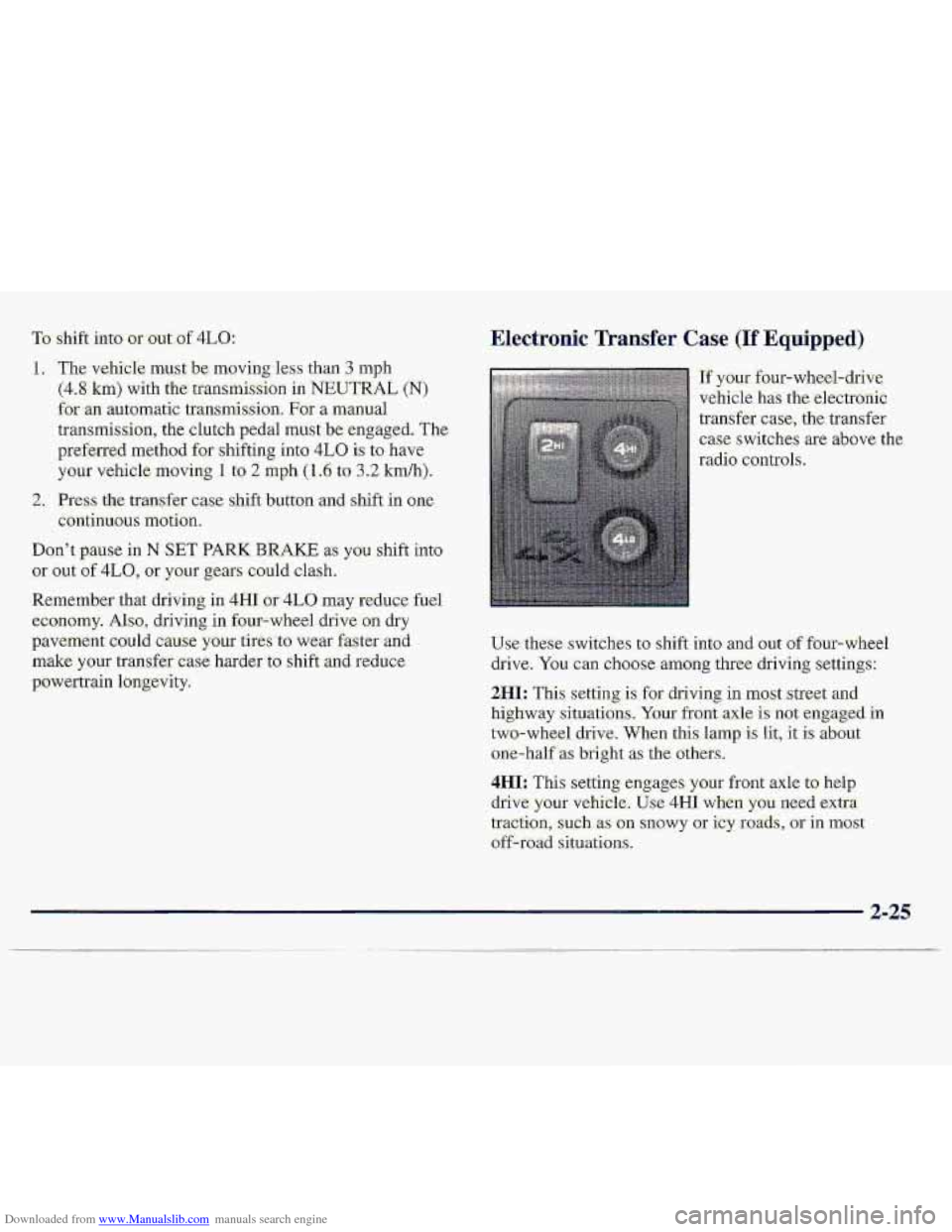
Downloaded from www.Manualslib.com manuals search engine TO shift into or mt. of 4LQ:
1. The-vehicle myst be movingless than 3 mph
(4.8 h) with the tfansrnissi-on in NEUTRAL (N)
fa an automatic transmisSion. Fm a n~anual.
transmission, the clutch pedal must
.be engaged. The
p-referred method for shi€tin.g into 4LO is to have
your vehicle moving
1 to 2 mph (1.5 to 3.2 Wh).
2. Press the trans€er case s:hi€t buttan .and shift in one
continuous motion.
Don't pausejn
N SET PARIK;BRAKE as y-ou shift into
or out of 4L0, or your gears could clash.
Remember that driving in 4HI ur 4LO may reduce fuel
ec-onomy.
Also, driving in fo.ur-whee1 drive:on dry
pavement could cause your tires to wear faster and
make your transfer case harder to shift and-reduce
powertrain longevity.
Electronic Transfer. Case (KEquipped)
I~y~~~-four-wheel-drive
vehicle
has the electrofiic
transfer
case, the transfer
case switches are above the,
radio controls.
Use these switches to shift into and out of four-wheel
drive.
You can choosea-rmng three driving settings:
2M[: This setting- is for driving in most .street and
highway situatibns ... Your front axle is not engaged in
two-wheel drive. When this. lamp is lit, it is about
orre-half as bright as the Others.
4HI: This setting engages your front axle ta- help
drive,
your vehitk. Use 4Hi when YOU. need extra
traction, such as
on snowy or icy rcmds, or in mast
off-road situations-.
Page 143 of 402
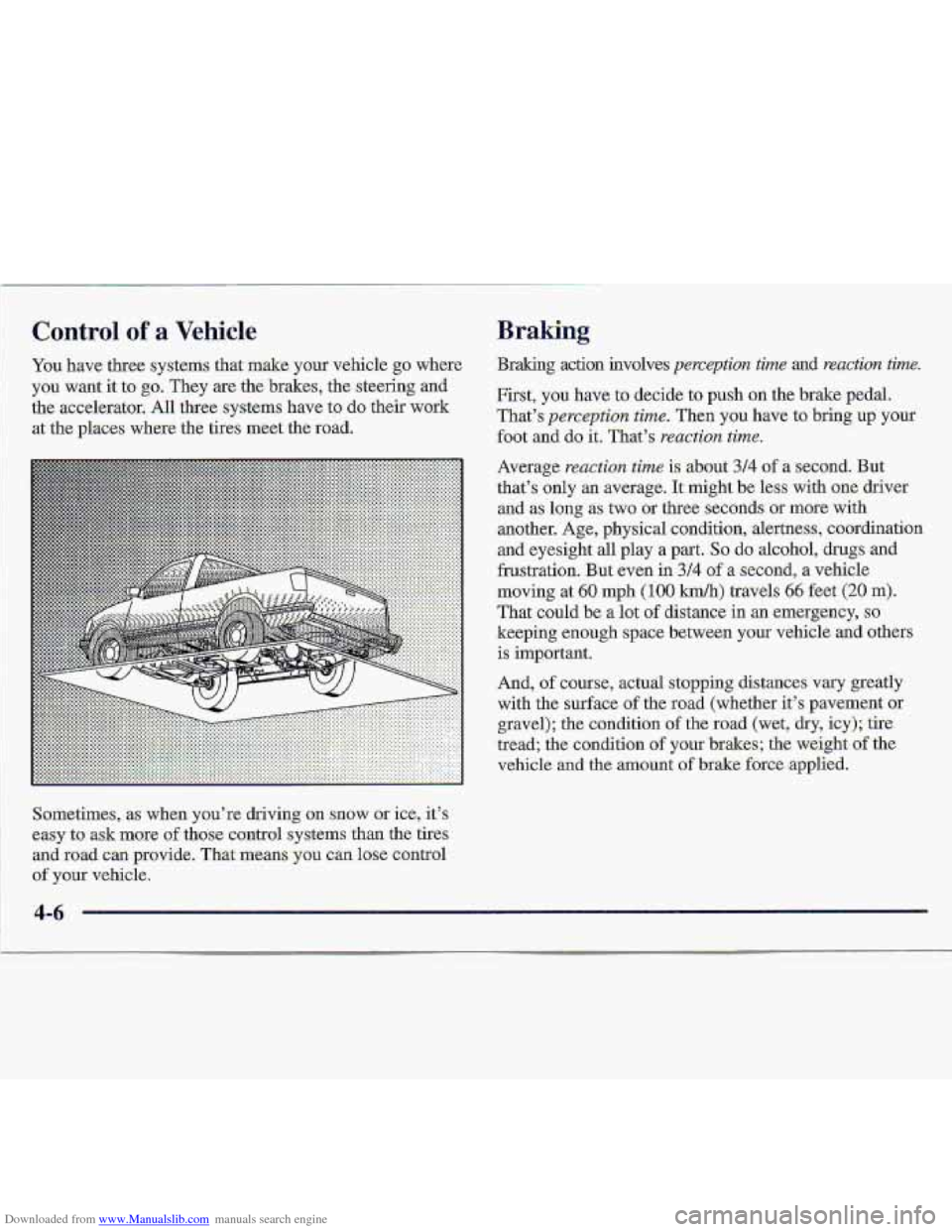
Downloaded from www.Manualslib.com manuals search engine You have three systems that make your vehicle go where
you want it to
go. They are the brakes, the steering and
the accelerator. All three systems have to do their work
at the places where the tires meet the-road. Braking action involves
perception
time and reaction time
First, you have to decide to push ob the brake pedal.
That’s
perception time. Then you.have to bring up your
foot and
do it. That’s reaction time.
Average reaction time is -about 3/4 of a second. But
that’s only an average. It might
.be less with me driver
and
as long as two or three seconds or more with
another. Age., physical condition, alertness, co.ordinati.on
and eyesight
all play a part. So do aIcohol, drugs and
frustration.
But even in 314 of a second, a vehicle
moving at
60 mph (100 km/h) travels 66 feet (20 m).
That could be a lot of distance in an emergency, so
keeping -enough space between your vehicle and others
is important,
And,
of course, actual stopping distances vary greatly
with the surface
of the road (whether it’s pavement or
gravel); the condition
of the road (wet, dry, icy); tire
tread; the condition of your brakes; the weight of the
vehicle and the amount
.of brake force applied.
Sometimes,
as when you’re driving on snow or ice, it’s
easy
to ask more of those control systems than the tires
and road can provide. That means you can lase c.ontrol
of
your vehicle.
4-6 .-
Page 150 of 402
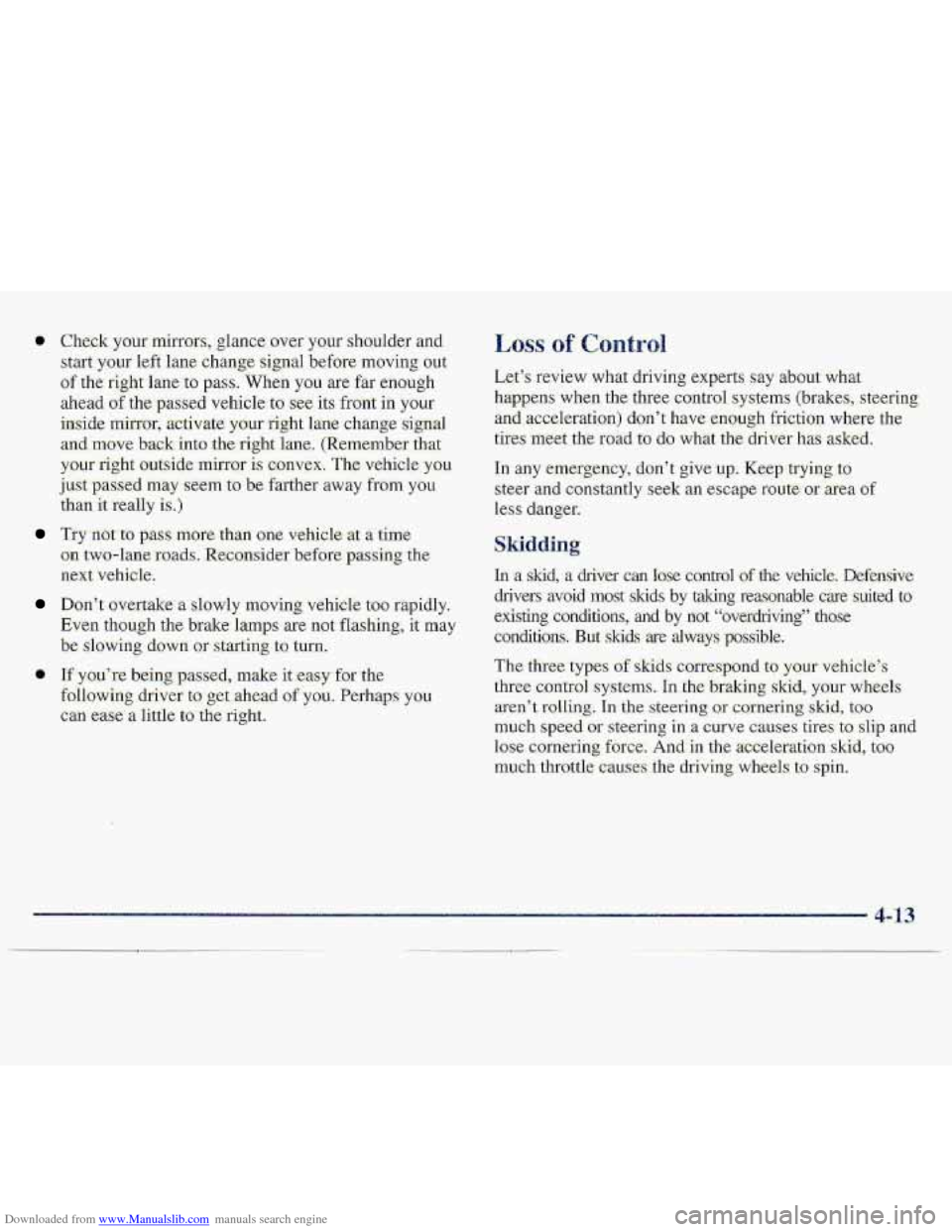
Downloaded from www.Manualslib.com manuals search engine * Check your mirrors, glance over your shoulder and.
start your left lane change
signal before-moving out
of the right.lane to pass. When you are far enough
ahead
of the passe.d vehicle to see its front in your
inside -01, activate your right lane change sigmd
and-move back into the.
ri,ght lane. (Remember that
your-right outside ,mirror is convex. The vehicle you
juslpassed may
seem to be farther away from y6u
than it really is.)
Tfy not co p.ass mufe ,than one vehicle ,at a time
on two-lane’roads. Reconsider before passing the
next vehicle.
D.on’:t overtake-.a slowly moving vehi-de too rapidly.
Even though
the brake -1amp.s are not flashing, it m.a.y
be slowing down or starting to, turn.
Qi If+ you’re being .passed, make it easy- for the
fallowing driver to
get..ahead .of you. Perh,aps you
can ease.&
little to the right.
Let’s review what driving expmts s-ay about what
happens when the thre.e
con.trol systems- (brakes., steering,
and,acceleration) don’t
have enough friction where the
tifes ”meet the road to do what the drivt?r has asked..
In any emergency, don’t give up Keep trying to
steer and constantly seek
an escape route-or aea of
less danger.
In a. skid, a driver cn lose control of .the vehicle, Defensive
drivers .avoid
most skids by taking reasonable care suited t9
existing conditiolrs, and by not “overdriving” those
conditions.. But- ,&ids
are always -pa.ssible.
The three typcis of skids correspond to your vehicle’s
three
c’0ntro1 syst,erns. In. the. brakifig skid, y0.m whe.eIs
aren’t rpl.ling. Ln the steering or- cornering skid, too
much speed or steering in a curve causes tires: to slip and
lase cornehg, foxce,. And. in the acceleration skid, too
much throttle causes the driving wheels- to spin.
4-13
Page 152 of 402
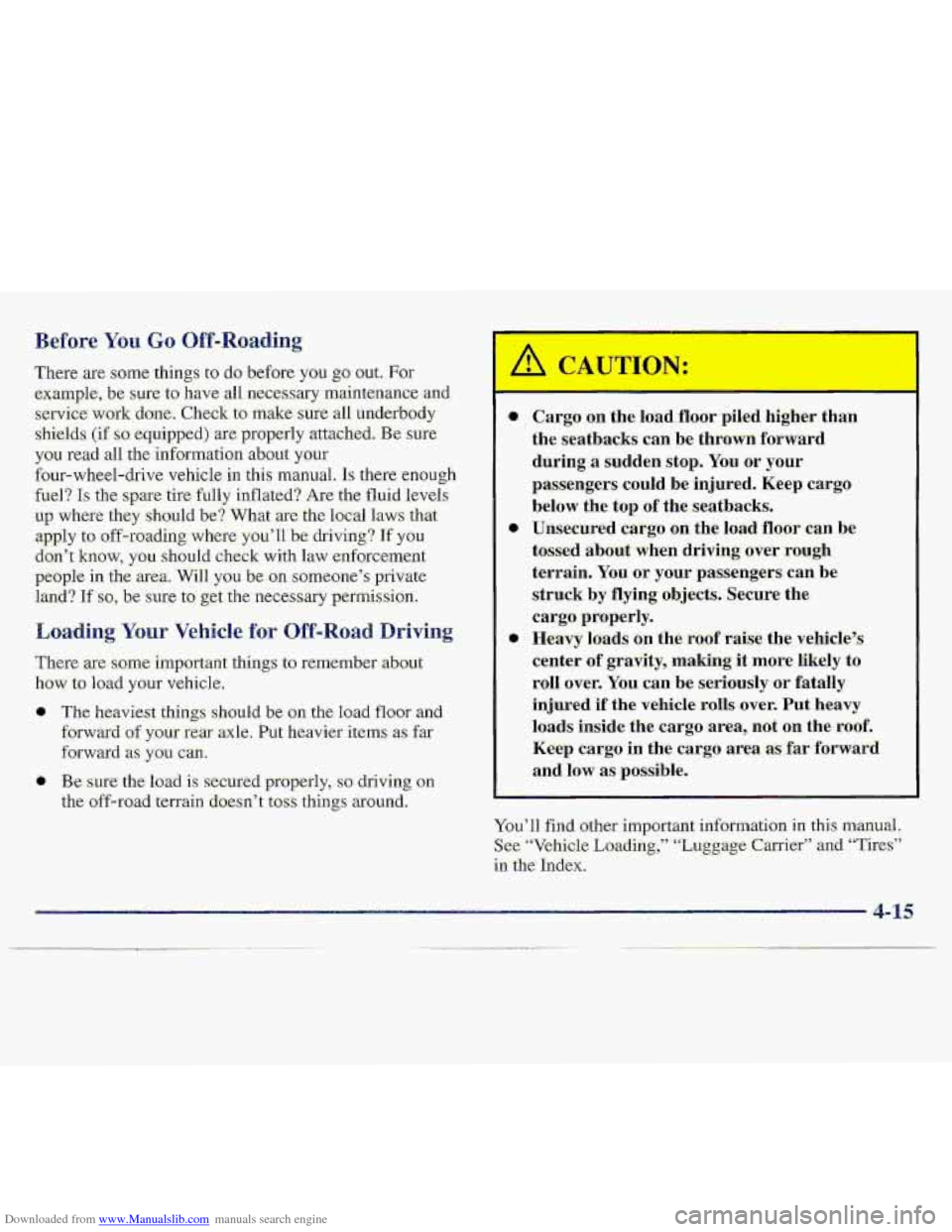
Downloaded from www.Manualslib.com manuals search engine 0 The, heaviest things s.hould be on the load floor and
forward of your rear axle. Put h-avier items as far
forwardas you~~m.
0 Be- sure- the- imd is secured properly, so driving on
the off-road terrain doesn’t toss things around.
0
0
0
Cargo on the loa-d.-floar .piled. higher than
the seatbacks can
be thrown €ofward
during a sudden stop. You or y0u.r
passengers could be injured. Keep cargo
below the top
of the seatbacks.
Unsecured
cargo on the load floor can be
tossed about; when driving, over rough
terrain. You or your passengers can be
struck-by flying objects. Secure the
cargo properIy.
Heavy laads on the roof raise the vehicle’s
center
of gravity, making it more likely to
roll over, Yuu .can be seriously -or fatally
injured if the vehicle rolls over. Put heavy
loads iiiside thexargo .area, not on the roof.
Keep cargo in the cargo ar
and low as possible. wward
You‘ll find other important information in this manual.
See “Vehicle Lo-ading,” “Luggage C.arrier” and “Tires”
in the
Index.
4-15
Page 164 of 402
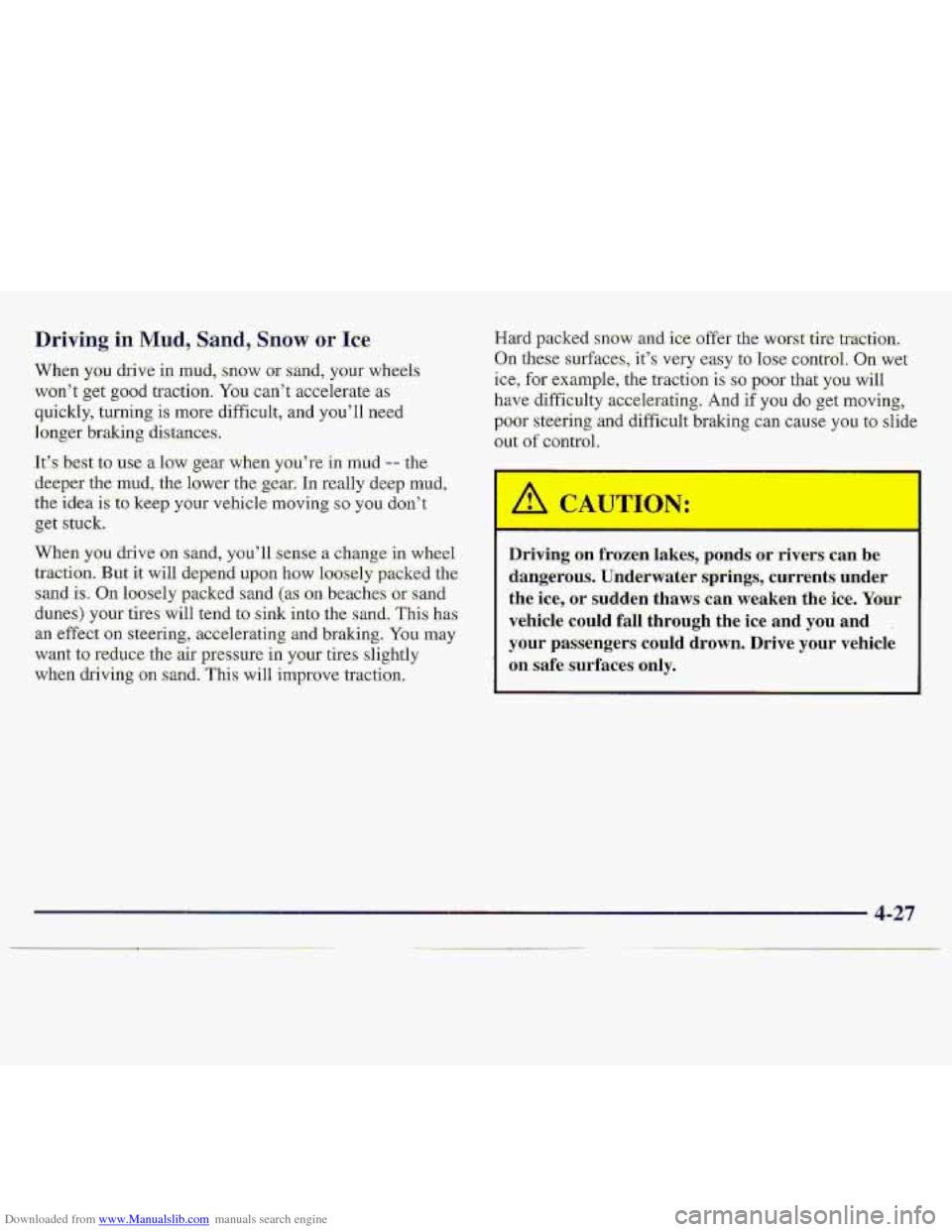
Downloaded from www.Manualslib.com manuals search engine Driving in Mnd, Sand, Snow or Ice
When you dxive in mu.d, snow or sarsd, your wheels
won’t get good traction. You can’t accelemte as
quickly, turning i.s more dif€icult, and you’ll need
longer braking distances.
It’s best .to use a low..gear when you’re in mud -- the
,deeper the mud, the lower the gear: In really ,deep mud,
$he idea is to keep your vehicle- moving s.0 you don’t
.!get stuck.
When
you drive on sand, yo-u’ll sensg a change- in wheel
traction, But St will &pmd upon how looseiypacked the
,sand is. On loosely packed sand (as on. beaches or sand
dunes)
your tires will tend to sink into the sand. This has
an effect on steering, accelefating and braking. You may
,w.ant to reduce the air pressure in your tires slightly
when driving on :sand. ‘This. will improve traction,
Hard packed mow ;sad ice. oEer the wofWtire’tractioa.
On thes~e s-Urfac.e.s, it’s very easy to lase c.on!Td, On wet
ice, for example, the traction i.s so paor that you will
h,ave diffic-ulty
accelerating, And if you d:o gkt movi.ng,
poor sleeting and difficult braking- can cause you to slide
out of control.
Driving on frozen lakes, ponds or rivers can be
dangerom. Undewater sprirmgs, currents under
the ice, or
sudden thaws can weaken the ice, Your
vehicle could fall through the ice and you and ,
your passengers could drown. Drive your vehicle
on -safe-surfaces only.
Page 165 of 402
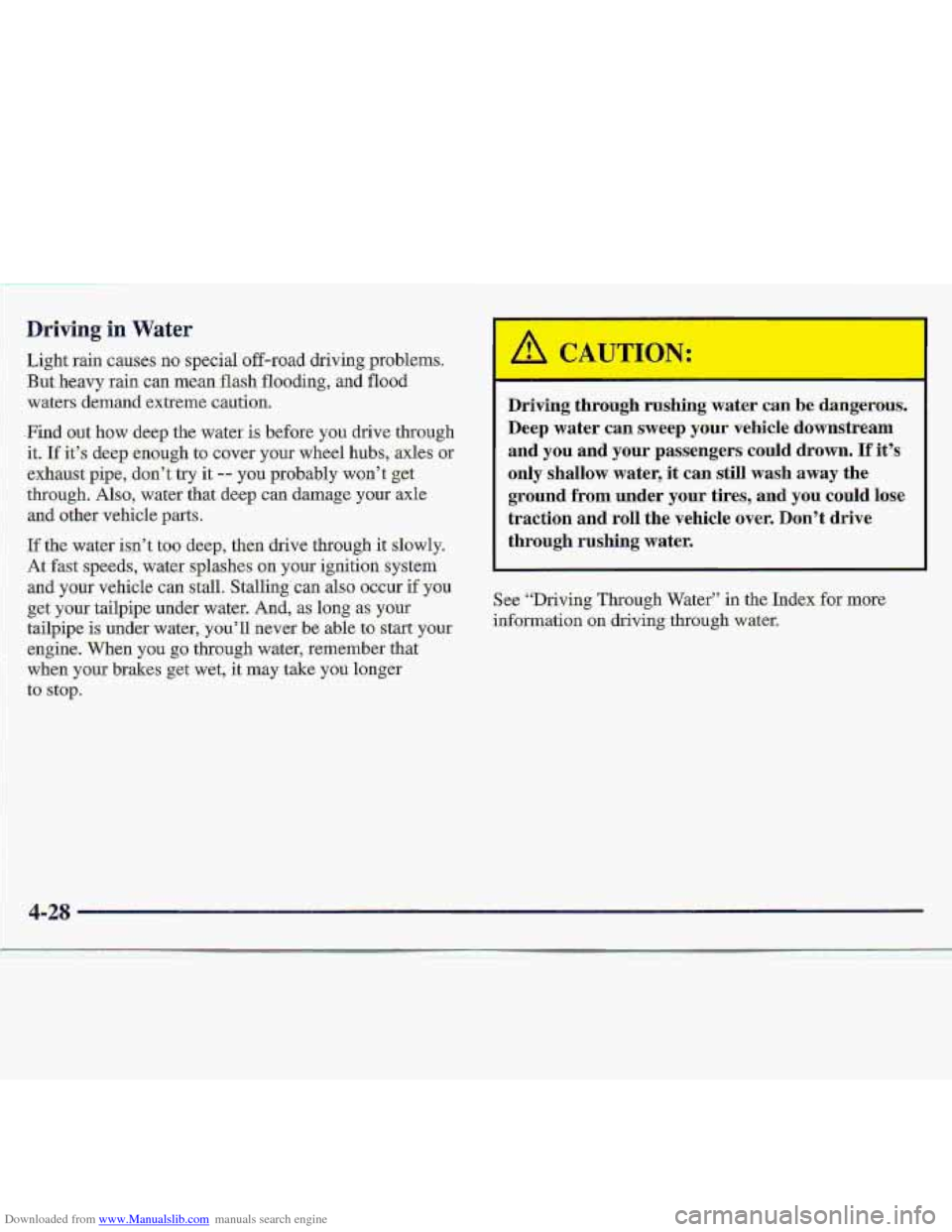
Downloaded from www.Manualslib.com manuals search engine Driving in Water
Light rain causes no specialaff-road driving problems.
But .ke.avy rain
can .mean flash flooding, and flood
waters demand extreme caution.
+Find- out how deep the water is before you drive through
it. If it’s deep enough to cover your wheel hubs, axles or
exhaust pipe, don’t
‘try it -- you probably won’t g-et
through. Also, water that deep
can damage your axle
and
other vehicle parts.
If the water isn’t too deep, then drive through it slowly.
At fast speeds, water splashes on your ignition system
and your vehicle
can st-dl. Stalling.can also occur if you
get your tailpipe under water. And, as long as your
:.. . tailpipe is ,under water, .you’ll never be able to start your
..;;&I
engine. When you gp through water, remember that
--.
. ,. , when your brakes get wet; it may take you longer
to stop. -‘a:i <,..,..?, ,
Driving through rushing water can be dangerous.
Deep water can
sweep your vehicle downstream
and you
and your passengers could drown. If it’s
only shallow water,
it can still wash away the
ground
from under your tires, and you could lose
traction and roIl the vehicle over.
Don’t drive
through
rushing water.
See “Driving Throagh Water” in the Index f6TmGE
infoination on driving through water,
4-28
Page 166 of 402
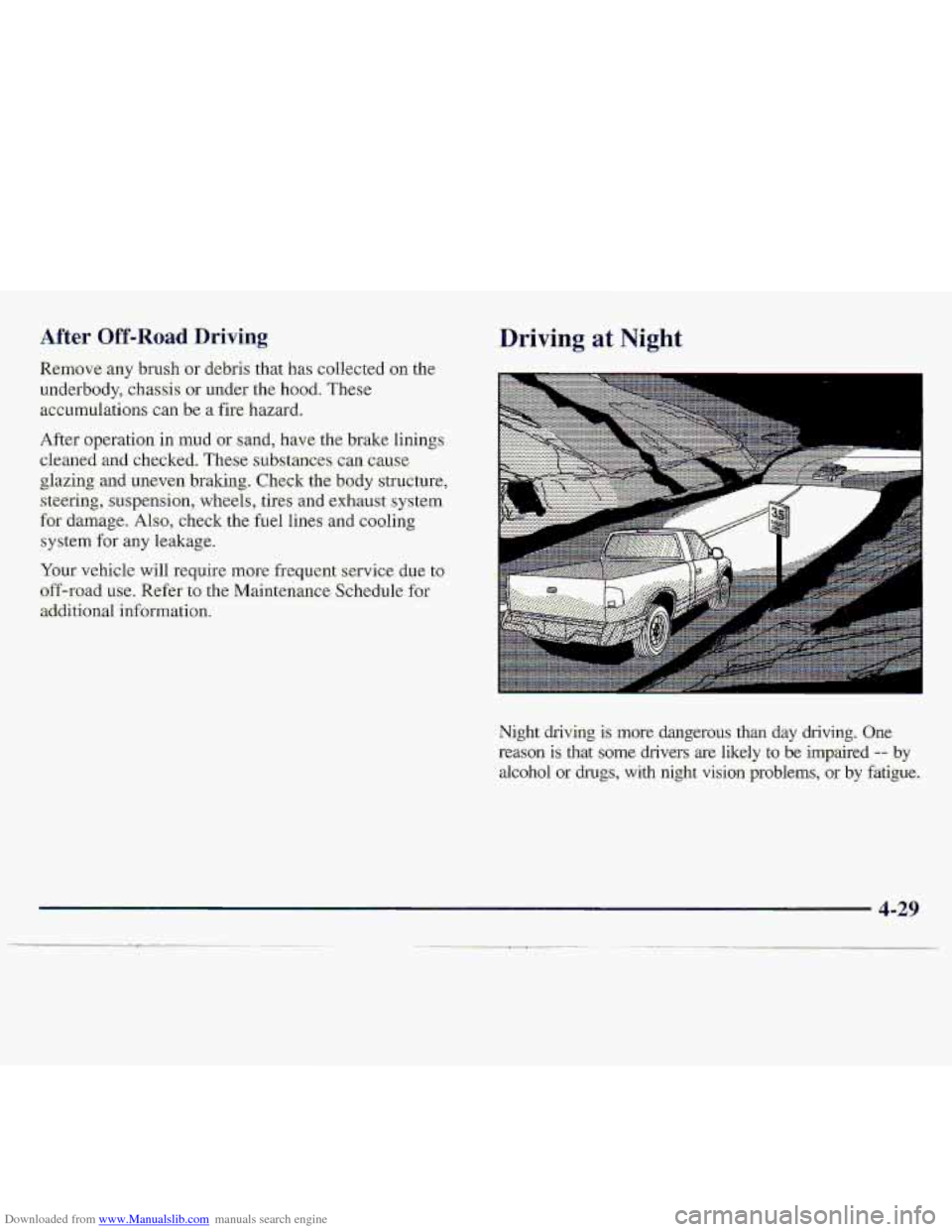
Downloaded from www.Manualslib.com manuals search engine After Off-Road Driving
Remove .any brush. or debris th.at has collected an. the-
underbQdy, chassis
or under the hood. These
accu.mulation-s
can be a fire hazard.
After
operation in mud or. sand, have the br&e linings-
cleaned -and checked. These substances can cause
glazing- and uneven braking,. C,heck tihe, body struc.ture,
steerbig, su$pensioonj
wheels, tires .-and exhaust system
for damage, Also, check the file1 lines and cooling
system for any leakage.
Your vehicle will req.uire more frequent service due to
aff-rrrad
use.. Refer to the Maintenance Schedule fo,r
additional infofmation.
.Driving at Night
Night driving is more dangerous th-an day driving. One
reason is that some drivers are likely to be impaire-d -.- by
alcohol or drugs, with nieht vision broblems, or by fatigue.
4-29
Page 168 of 402
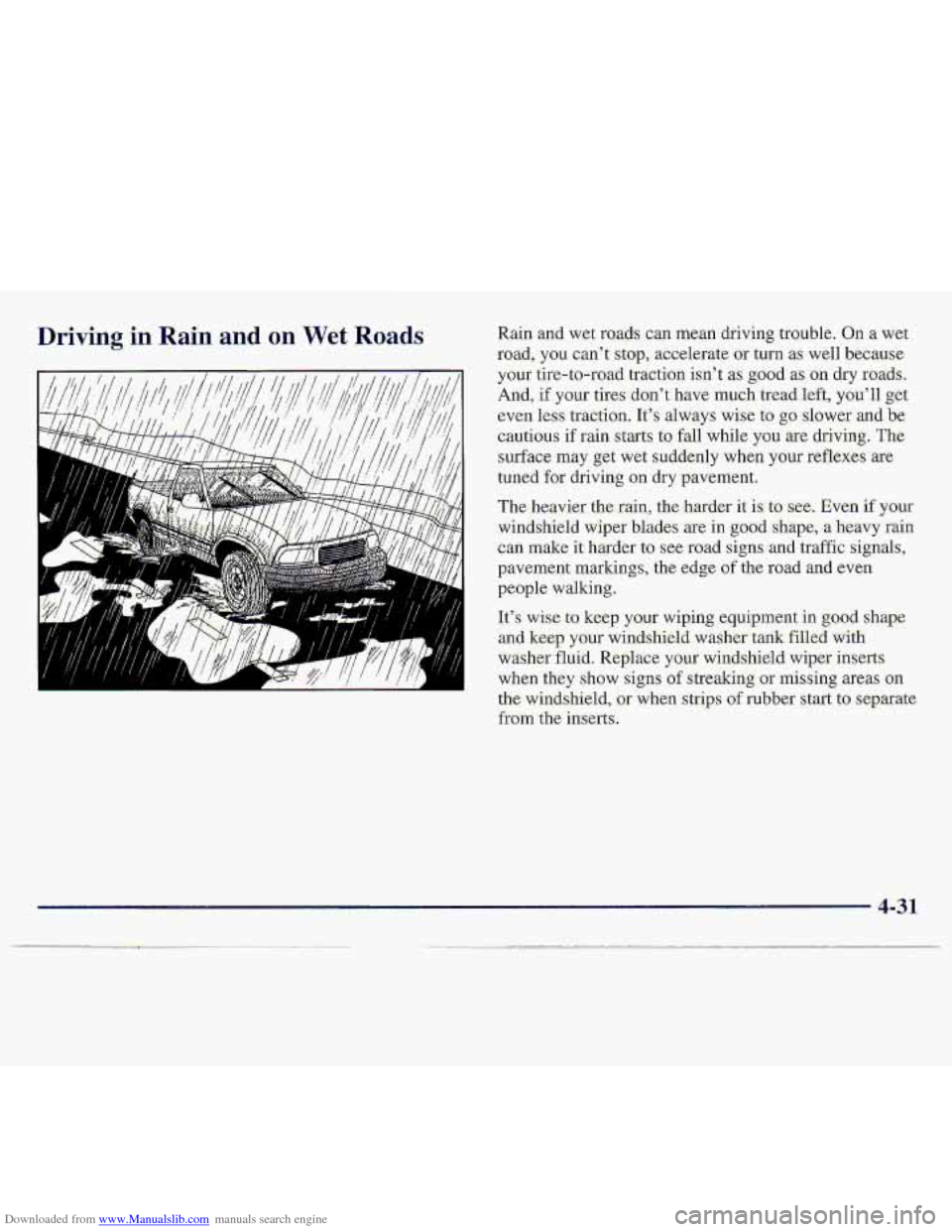
Downloaded from www.Manualslib.com manuals search engine D-riving in Rain and on Wet Roa ; Rain and wet roads can mean driving trouble. On a wet
-road,
you can’t stop, accelerate or turn as well because
your fire-to-road traction isn’t as good.
as on dry roads.
Arid, if your tires don’t- have much tread
.left, you-’11 get
even less traction. It’-s alway,s wise to go :slower and.be.
cautious
if rain starts to fall while you are driving. The-
surface may get wet suddenly when your reflexes are
tuned for driving o,n dry pavement.
The heavier the rain, the harder it is: to see. Even if your
.windshield wiper blades
are in good shape, a heavy rain
can make it harder
to see road signs and traffic signals,
pavernent.maskings, the
edge sf the road and even
people walking.
It’s wise
to ke,ep your wiping equipment-in gaod shape
and keep your windshield washer tank-filled with
washer fluid. Replace
your windshield wiper inserts
when they show signs
of streaking or missing areas on
rhe windshieJd, or when strips of rubber start to sep-arate
from The inserts..
4-31